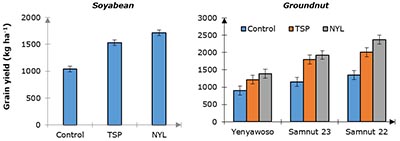Recommendations for best-fit technologies
| A large number of diagnostic, demonstration and adaptation trials was established in 2017 (see Table 1) and results of these trials have again contributed valuable information to the dataset of prior years. |  |
The combined results of yields and farmers’ evaluations of diagnostic, demonstration and adaptation trials over multiple years and seasons led to the development of best-fit recommendations for the different legumes in the core countries (table 2).
| In Ghana, New Yara Legume (NYL) fertilizer (NPK, Ca, OMg2, OB; 4:18:13:14:2.8:0.3) and TSP were compared in their effects on the yields of soyabean, groundnut and cowpea, and NYL application resulted in larger yields than TSP application (P< 0.05). Figure 1 shows the results for soyabean and groundnut, and also cowpea yields were significantly larger with NYL (1380 kg ha-1) than with TSP (1250 kg ha-1) inputs. The difference in performance of cowpea and soyabean varieties in different parts of the country in both diagnostic and demonstration trials led to tailored recommendations about the suitability of varieties for different parts of the country. The early maturing soyabean variety TGX 1985-10E was outperformed by the other two improved varieties Afayak and Suongpungun in terms of yield but was still considered suitable in case of late planting. |

|
 |
In Ethiopia, agronomic studies to develop recommendations for soils non-responsive to inoculation and P-fertilizer showed that additional application of 30 kg ha-1 of S (sulphur) was recommended for chickpea production in Northern Ethiopia. A combined application of K2O (60 kg ha-1) and lime (4.6 t ha-1) was recommended for soyabean production in acidic soils in Western Ethiopia. In northern Tanzania, largest bush bean yields were achieved when (N)PK fertilizer was applied in combination with inoculants. For groundnut a combined application of farm yard manure, Minjingu Rock Phosphate (MRP), and a little gypsum is recommended. Farmers gave positive feedback on that combination of inputs because those inputs are readily available and not considered very costly. Aflasafe – a bio-control agent against aflatoxin-producing fungi – was applied in addition to the fertilizer treatments to assess the impact of agronomic practices on its efficacy. Aflasafe reduced aflatoxin levels up to about 95% in all treatments. In Uganda, diagnostic trials were conducted to identify the nutrients that are needed to close the yield gap related to soil fertility. Previous trials with soyabean and climbing beans have shown that the combined application of P in combination with either inoculant or manure was not enough to close yield gaps. For soyabean, inoculation and lime resulted in significant increases in yields compared to the control or lime alone, and yields of inoculation and liming with P were significantly better (1,526 kg ha-1) than without P (1,383 kg ha-1). The addition of K, N, Mg, Ca, and micro-nutrients did not result in a significant change in yield until manure was added, resulting in a maximum yield of 1,872 kg ha-1. The economic viability of the nutrient combinations – particularly inoculants alone, inoculants + P, and inoculants + P + manure – should be assessed and related to farmers’ capacity to purchase. Climbing bean grain yields showed significant responses to lime application and combined application of lime + P. This reiterates the need to manage soil acidity in the highland areas to improve climbing bean productivity. It could also explain the responses to manure and P application in some demonstration trials in previous years; manure may have provided partly the same function as lime. The liming contribution of manure needs to be evaluated, as manure could be a potential alternative option to agricultural lime in climbing bean production for those who can access it. |
Adaptation trials
In the adaptation trials, mean legume yields varied from 300 to 2,600 kg ha-1 on the N2Africa plots, and from 400 to 2300 kg ha-1 on the own legume plots (measurements on 10 x 10 m plots) (Table 3). Mean yields significantly increased on all N2Africa plots compared with the own legume plots, except for Uganda (differences not significant). Farmers generally saw an increase of 300 to 800 kg ha-1 on the N2Africa plot compared with their own legume. In relative terms, farmers growing cowpea or bush bean in Tanzania and soyabean in Nigeria on average (more than) doubled their yields. Generally, more than half of the farmers had a yield increase of > 50% (except for Uganda). Note, however, that there is an experimental error associated with using measurements from sub-plots which may inflate the proportion of fields with more than 50% yield gain.
The lack of increase in legume yields on the N2Africa plots in Uganda may have been caused by dry spells in parts of the country which limited the number of trials that could be harvested and depressed legume yields. In Tanzania, the positive effect of the use of P-fertilizer in adaptation trials with cowpea was larger in eastern Tanzania than in other parts of the country, suggesting that P-fertilizer is especially recommended for cowpea in eastern Tanzania.

Learning pathways
In 2017, we also captured the “learning pathways” that have led to changes in demonstration trials from 2014 up to 2017; describing the main reasons behind moving from best-bets to best-fits (http://www.n2africa.org/tailoring-and-adaptation-n2africa-demonstration-trials). Common reasons to discard varieties in demonstrations were poor yields (often the result of increasingly irregular rainfall patterns). Introduced varieties were therefore in most cases selected based on their drought tolerance (early maturing varieties replacing late maturing varieties) and better yields. For groundnut, there was also a clear selection towards varieties with high oil content and with a good taste to accommodate market demand. Changes in inputs described specifically for 2017 were that LEGUMEFIX was added to bush beans in demonstration trials in Tanzania because results elsewhere (Ethiopia, Rwanda) indicated a response to inoculation in common bean. In Ghana, TSP was replaced by New Yara Legume for fertilizing cowpea and soyabean. In Uganda, herbicide Beans Clean was introduced in 2015B to produce bush beans, climbing beans, and soyabean to reduce the labour intensity of weeding. Some weeds persisted after the application of Beans Clean so a stronger, broad-spectrum glyphosate herbicide was introduced in 2017 to use in combination with or instead of Beans Clean.
Feedback from farmers was very often the basis of changes. Evaluations with farmers are clearly necessary to steer practices towards best-fits within a regional context with its specific weather and market conditions. Other lessons learned from capturing these changes were the need for varieties that are more tolerant to changing and irregular weather conditions while still being high-yielding and marketable. The availability and accessibility of legume-specific inputs such as certain rhizobium strains (Ethiopia), TSP (Tanzania, Uganda) or DAP (Ethiopia) were often a problem, stressing the importance of networking with partners and of lobbying with policymakers.
The N2Africa impact design
The project impact evaluation will be based on the theory of change and its related results framework with distinct results at output, outcomes, and impact levels. The design will combine both quantitative and qualitative methods to ascertain the impact of the project. The assessment of the baseline indicates the absence of relevant baseline data in different countries that include all the outcomes of interest against which the end-line is going to be compared. This has conditioned the type of approach to be used for the impact assessment. Areas of potential impact have been selected across all core countries regardless of the existence of baseline data. A mixed approach will therefore be used to collect data as well as to estimate impact. The quantitative methods will include the use of Propensity Score Matching (PSM) and Endogenous Switching Regression (ESR) to compare the beneficiaries with non-beneficiaries of the project. Due to the challenge of assessing the effects between the treated and non-treated using the PSM which focuses on observed variables, the ESR will be used in addition to model the counterfactuals through the inclusion of an instrument in the survey tool to measure the unobserved.
With regards to qualitative methods, focus group discussions and key informant interviews will be used to collect additional information across areas that the impact evaluation might not cover and also areas where the project was implemented but the country teams do not expect observable change. These cases and the reasons for the lack of change will be assessed based on the experiences of country teams and partners, with additional focus group discussions with farmers and other key stakeholders where necessary. The assumptions underlining the theory of change will be tested here as well, forming the basis of the guiding questions. Also, institutional information and community level data will be collected using qualitative methods. Assessment of the effectiveness and efficiency of dissemination approaches and input supply strategies has been conducted in Tanzania, Ghana, and Nigeria. A similar study is to be done in Ethiopia, Nigeria and Uganda. These studies can serve as additional background information to the impact assessment.
Link to the N2Africa Annual Report 2017
Compiled by Eva Thuijsman, Wageningen University & Research
